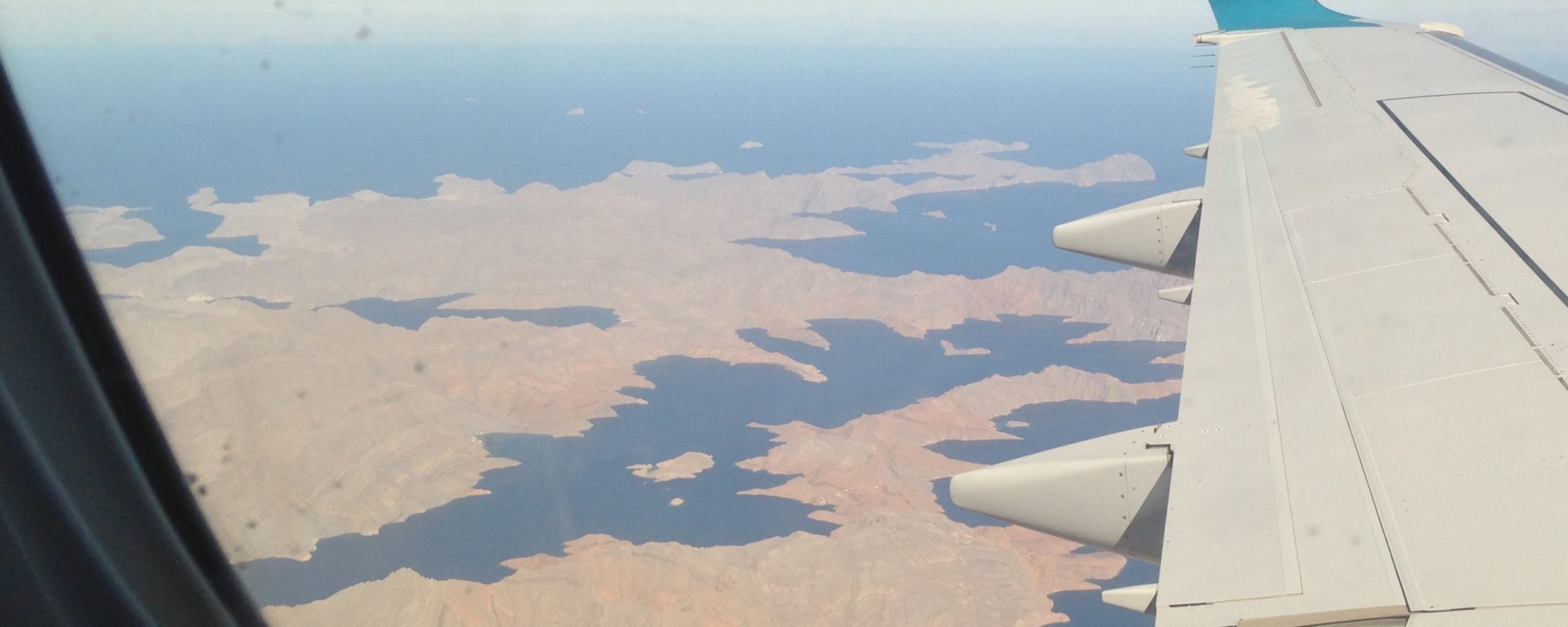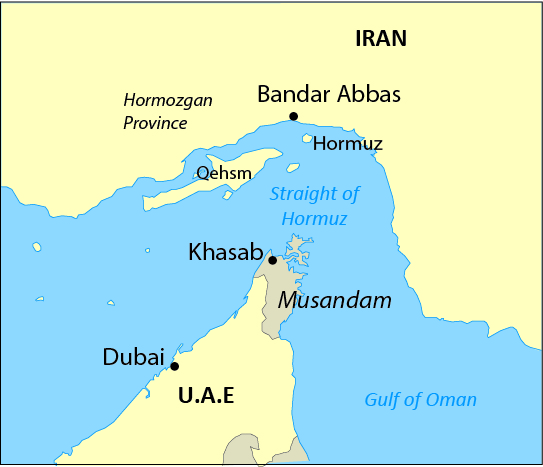The beguiling rhythms of the tide have drawn Omanis seaward for millennia, and ancient routes and industries have continued into the present day. Oman’s biggest centers of population are former ports of importance, and their residents live at the mercy of the ocean, drawing their livelihood from fishing and seaborne trade. Nowhere is this more evident than on the Musandam Peninsula, Oman’s lonely exclave that reaches out toward Iran. Twenty percent of the world’s oil floats past its shores each day, past coves and inlets where Omanis live in stone villages accessible only by boat, making the Musandam feel alternately like it is at both the center and the edge of the world.
If the northern Arabian Peninsula is viewed as a rhino’s head with Qatar as its ear, Musandam is the tip of the horn that pokes into Iran’s Hormozgan province, creating a divot near Bandar Abbas, that region’s capital and largest city. The Musandam is a rugged, unforgiving landscape. It is the terminus of the Hajar Mountains, the same range that serves as a backdrop for Muscat. But in Musandam, there is no coastal plain — waves crash at the base of the mountains, creating snakelike fjords and bays that gave the region its confusing tagline “Norway of the Middle East.” The peninsula is boxed in along its southern border by the Emirates, with just three overland crossings: one at Wadi Sham on the western coast, one at Dibba on the eastern coast, and a much smaller and remote crossing in the mountains at Wadi Bih. The paved roads to the borders were completed in the 1990s, which opened vital trade and social lifelines for the otherwise remote outpost.
Inhabitants of the greater Persian Gulf have held varying degrees of loyalty to the al Busaidi sultans of Oman throughout history, but the Shihuh tribe, which dominates the Musandam Peninsula, have long been steadfastly allegiant. Prior to the discovery of oil, Oman was synonymous with overseas trade and prosperity, and tribes from modern day Qatar, Bahrain, the Emirates, and Iran aligned themselves with the merchant sultans of Muscat for their own gain. In the mid-19th century, Musandam was a bookend to the many ports of Oman’s northern coast, which were far more numerous than the then-sparsely populated backwater of Trucial Oman, now the United Arab Emirates. The Trucial coast was named for the 1853 Perpetual Maritime Truce that united the sheikhs of Dubai, Abu Dhabi, Ras al Khaimah, Ajman, and Umm al Quwain — the first five of what later became the seven Emirates.[i] Musandam, which might have been an eighth Emirate, was firm in its allegiance to the Sultan of Oman, Said bin Sultan (or “Said the Great”), who had by then already moved his capital from Muscat to Zanzibar.
Oman’s historical suzerainty over the Musandam became a strategic coup for the Sultanate with the advent of petro-economics in the region and eventual formation of the Gulf Cooperation Council (GCC). The peninsula’s western shores are Oman’s entrepôt into the Persian Gulf, as the body of water off Muscat and the rest of northern Oman is the Gulf of Oman, which is seen as politically and geographically separate. Importantly, Musandam comprises the entire southern half of the Strait of Hormuz, the gateway to the Persian Gulf, and waterway that the U.S. Energy Information Administration (EIA) has called the “world’s most important chokepoint.”
The EIA has estimated that 30 percent of all oil transported by sea passes through the Strait, a total of 17 million barrels per day.[ii] The designated shipping lane that cuts through Hormuz is like a superhighway: a two mile wide inbound lane, a two-mile outbound lane, and a two-mile median between. A constant armada of Very Large Crude Carriers (VLCCs), Ultra Large Crude Carriers (ULCCs), and supercontainer ships squeeze through the Strait each day, while a steady swarm of fishermen and small-scale merchants duck and weave in their wake. The lanes are largely within Omani territorial waters, but are also within Iran’s Air Defense Identification Zone, which is as subjective as the name implies. Maritime territorial claims and differing definitions of international waters have lead to disputes across the world, and Hormuz is no exception.
The port of Khasab, Musandam’s largest town and the seat of local government, is about 40 miles by sea to the closest populated parts of Iran, and about 65 miles to Bandar Abbas. Like Oman and East Africa, a long history of trade, fluid boundaries, and intermarriage connects the Sultanate with southern Iran. Musandam was once part of Ormus, a medieval Persian seafaring kingdom that was eventually folded into the Portuguese empire. An endangered language derived from Persian, Arabic, Portuguese and Hindi called Kumzari is spoken in contemporary Musandam and the islands of southern Iran.
I went to Khasab this month, hoping to learn more about what has been called “the most important nowhere on earth.”[iii] I had planned to take the ferry from Muscat, but the service was canceled for the week due to high seas. Instead, I was able to catch an Oman Air flight that departs daily for Khasab Air Base, a Royal Air Force of Oman detachment. A small building on the base serves as the commercial airport, but is staffed entirely by Air Force cadets, save for a single Oman Air representative. As we deplaned, armed men in khaki jumpsuits and camouflage turbans boarded an NH90 helicopter on the tarmac.
There are no taxis in Khasab, so I walked the six kilometers from the air base to the port, where I had arranged to stay. Like many villages of Oman, goats wander indiscriminately throughout the town’s dusty streets, and clusters of date palms tower above winding stone walls. That night, as I ate fish kebab and rice outside an Iranian restaurant near the port, a voice called over to me.
“Siddiqi,” yelled a man smoking a skinny cigarette, using the Arabic for “my friend.” He wore a Members Only jacket over his dishdasha, and his turban was tied sloppily in the Bedouin style, and cocked slightly to one side.
“Aywa” I blurted out mid-bite, using the colloquial affirmative. The smoking man and I then exchanged the usual lengthy Omani pleasantries as the rest of the men at his table looked on, agape. Arabic-speaking Westerners are far less common in Musandam than in Muscat.
“Ta’al, ta’al bil shai,” he said, signaling for me to join them for a cup of tea. He rose as I brought my plate of fish over, and introduced himself as Ahmed. The Iranian waiter brought out a fresh pot of tea and empty cups, each of which had a rock candy sugar stick in it. Ahmed explained to me how he had tea just like this when he visited Shiraz, something he was proud to tell me.
Ahmed and his friends were fishermen and seafaring entrepreneurs, each with their own boat that they used for fish, tourists, or hauling goods between the many coves of Musandam. They paid for my fish kebab and insisted that they give me a ride back to my hotel, which was only a short walk away. I ended up spending the evening with them as they went about their standard preparations for the next day. We visited every fish market in and around Khasab searching for kan’aad, called Spanish mackerel or kingfish in English; one of the seamen’s next days guests, an Emirati group, demanded the fish specifically, and I had the feeling the Emiratis would have nothing less. As we rode around in their Toyota SUV, Abdullah, the kingfish-seeker, was wringing his hands worrying that they wouldn’t be able to find any.
Ahmad kept looking back at me saying in Arabic “You see? I tell him and tell him, but he doesn’t listen. The waves were too big today for good fish.” Nonetheless, after exhausting all of the fish markets, they began calling restaurants and asking the kitchen staff if they could buy a fish off them.
Later, we stopped at another hotel in Khasab, which lies just around the other side of the cove from the main port and is geared toward Western tourists. We joined another table of seamen who were smoking and peering into their phones when an Italian man, looking lost, came out and was signaled over by one of our tablemates. It was an arranged meeting, I quickly learned, for the Italian to book a trip on Ahmad’s boat. I ended up being the de facto translator, and they agreed on 30 Omani Rials, or US$75 for a trip to Kumzar Island, a price that I thought was high, but kept my mouth shut about.
As we drove back through Khasab passing the Portuguese-era fort, the seamen argued about which winds would be blowing on the way back from Kumzar tomorrow: the shimaal or the suheili. When they finally dropped me off at my hotel, nearly four hours after our happenstance meeting, a roadblock prevented them from getting closer than a few blocks. The male half of a large wedding party was lined up on the street, beating drums, waving shiny swords above their heads and singing tribal songs, so we said our goodbyes and I walked through the festivities.
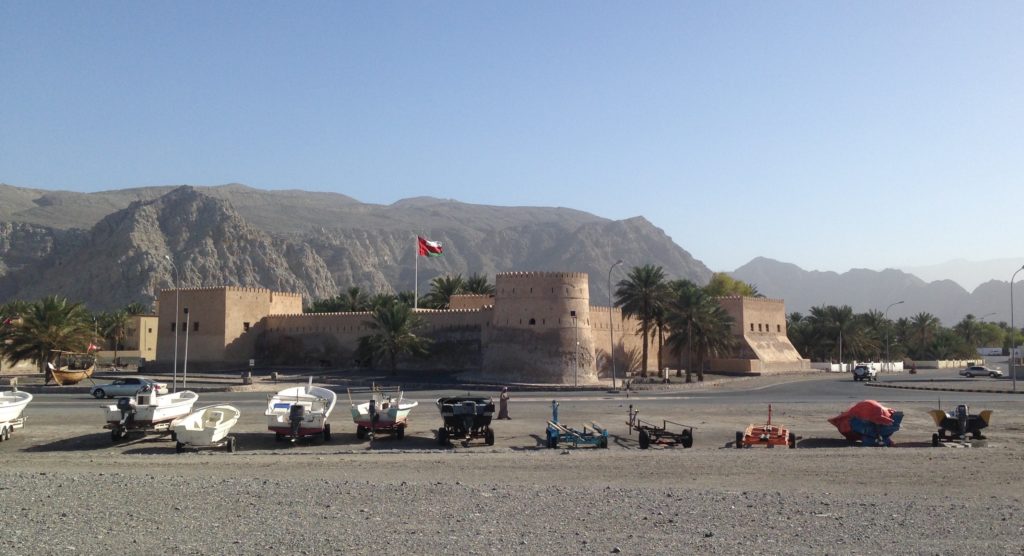
The next morning, I went for a walk on the jetty and watched as the fishing boats and tourist dhows prepared to venture into the waves. Khasab and Musandam are frequently associated with the smuggling trade in Iran, something I was eager to learn about. I arranged to join a number of Omani tourists on a boat headed for Telegraph Island, named for the British communications station that once connected India with the United Kingdom, and hoped that I would catch a glimpse of some of the fabled smuggling activity on the water.
I had read that smuggling had declined lately, in part due to the resounding success of the Jebel Ali Free Zone in Dubai and the loosening of sanctions in light of the Joint Comprehensive Plan of Action (JCPOA) between the P5+1 and Iran. Nevertheless, I was curious to see what smuggling activity I could see. At its peak, writers have indicated that hundreds (if not thousands) of smugglers sailed to Khasab each morning, their small boats loaded with goats and fresh produce. The most popular goods they brought back to Iran were cigarettes, cosmetics, air conditioners, and bulk food items like cooking oil, tea, and flour. Cigarettes, in particular, have been affected by the gradual increase of legal global trade with Iran, but the market for appliances seems to remain — at the glistening new Lulu Hypermarket in Khasab, air conditioners and washing machines dominate the appliances section, filling spaces labeled for fridges, stoves, and microwaves.
The Omanis I joined on the boat were from the villages of Liwa, Sinaw, and Nizwa, and had come to Musandam to see the fjords. They were bundled up in jackets and winter hats, facing the 65 degree Fahrenheit temperatures bravely. There was a Khasabi on board whom I sat next to and chatted with in the rough seas, and he explained that he was showing his friends from Nizwa around. We laughed as our wooden boat cracked and moaned as it dipped and rose like a cork as we were splashed us with ocean spray. Thinking I might pull some valuable information from my new friend, I asked about the smugglers, using the Arabic muharaboon, which unfortunately carries harsher negative connotation than the English. My new friend seemed exasperated and raised his hand to wag his finger at me, saying that the industry of “smuggling” is not illegal in Oman. He said that that Omanis don’t take boats to Iran, they just sell goods to the Iranian men who come to the port of Khasab in the morning and leave in the evening — it is the Iranians who were breaking laws, not Omanis. I could see how it might be exhausting to explain the system to curious outsiders and didn’t press the matter further, although I later overheard him talking of goats, electronics and cigarettes while pointing out a speedboat to his friends from Nizwa.

Scholar Michael Benz has said that most of the allure surrounding smuggling in Khasab comes from travel writers and journalists seeking to add an element of danger to their writing, saying that these writers “systematically try to sound adventurous and mysterious.”[iv] To an objective observer, however, the industry is quotidian. Shops in the “Iranian souq” are licensed as import/export businesses, and operate wholly within Omani law. At the port, trucks carrying goods to be sold to the Iranians pass through a Royal Oman Police checkpoint, and through a customs depot where their goods are weighed and taxed.
For the three days I spent in Khasab, I saw no more than a few dozen boats that were obviously smugglers. And of those, I caught a glimpse of only one instance of a truck offloading its goods onto the dock: crates of Lipton Tea. The Iranians who come to Khasab risk their lives taking small boats on the high seas, thumbing their nose at the Iranian government, but in Oman, they are as plain as any other expatriate worker. To Omanis, they are merely another example of the economy of trade whose roots span centuries.
Many writers have called the Omani government’s stance on the industry a “blind eye,” which seems appropriate, considering the otherwise cozy relationship the Sultanate has with the Revolutionary Government in Tehran. At the end of December, Oman and Iran held joint military exercises in the Strait of Hormuz, the latest in a series of occasional war games between the two countries. Joint agreements were signed in both 2013 and 2015 to boost military ties between them, drawing the ire of the perennially suspicious western observers of Iran. “All the interaction and cooperation between Iran and Oman is in line with maintaining permanent security in order to make others understand that Iran and Oman are capable of providing security for the Sea of Oman and the Strait of Hormuz” Iran’s Naval Commander Rear Admiral Habibollah Sayyari said in January, “and there is no need for the presence of others.”[v]
Iran’s state-run English language service Press TV covered the most recent exercise,[vi] reiterating that “Iran and Oman are both in charge of maintaining security and stability on the two sides of the Strait of Hormuz,” a fact that many Western governments are loathe to remember. Iran has a long history of anti-Western and anti-GCC rhetorical grandstanding, and makes no exceptions for discussing the Strait, which it has threatened to close often. While U.S. security experts have doubted the plausibility of this scenario, Tehran’s frequent military activities have been a source of anxiety for Western governments and corporations who fear interference with the 17 million barrels of oil per day that crosses the Strait.
On the morning of April 28th, 2015, the container ship Maersk Tigris lumbered past the island of Kumzar when bullets whizzed over its deck. Within minutes, members of Iran’s Revolutionary Guard had boarded the ship and redirected its course for Bandar Abbas. The ship and crew were detained by the military over a grievance issued by an Iranian court issued against the Maersk corporation, over a number of containers it says were mishandled (and ultimately impounded) in Dubai in 2005.[vii] It was strange timing, on the eve of a breakthrough between the P5+1 and Iran, and seemed less about the grievance with Maersk, and more about reminding the West that the Iranian military will do what it pleases when it pleases within its maritime boundaries. Oman played no role and offered no comment.
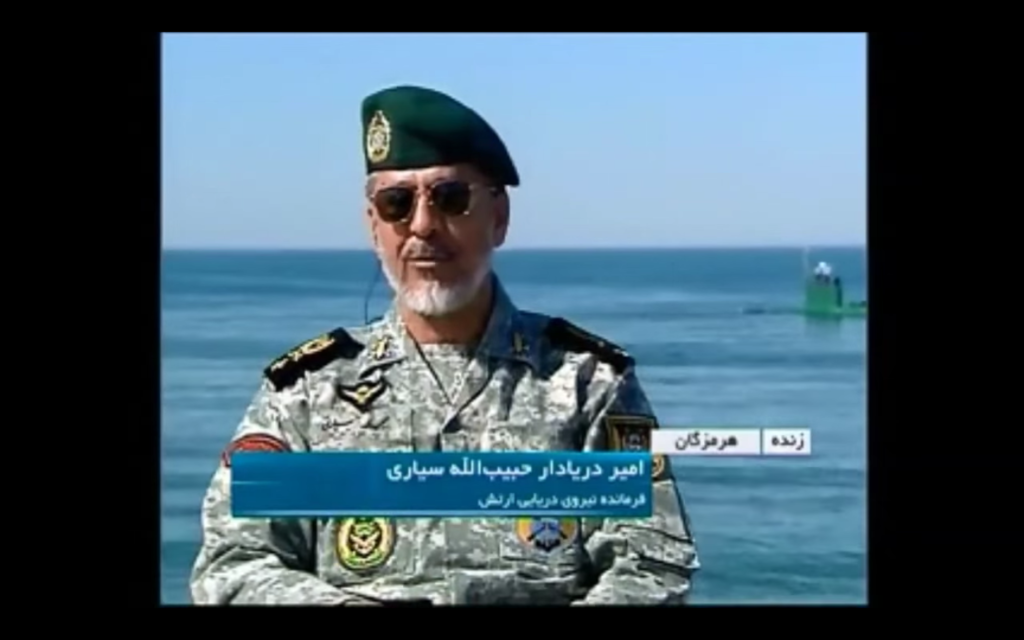
Many analysts have also speculated that Iran will seek to control or even invade Musandam, giving it control of both sides of the Strait. This seems unlikely — the residents of Khasab are far more aligned with the Emirates than they are with Iran, so popular support from the locals is doubtful. Moreover, Khasab often feels like a military installation first and a port second. The RAFO Khasab base takes up half of the village, and the Royal Navy and Ministry of Defense have a substantial presence. Despite Oman’s close ties with Iran, it is also a direct and valued ally of the United States, and the U.S. aircraft carriers that float around the Persian Gulf would no doubt come to Oman’s immediate assistance in the event of a crisis.
But in light of Iran’s potential for increased antics, bypassing the Strait is a logistical puzzle that Saudi Arabia, Qatar, and the Emirates have laid out plans to do, all of which remain theoretical. Only the Emirates has the port of Fujairah, on the Gulf of Oman side of the Strait — served by a pipeline inadequate to transport more meaningful quantities of oil from the productive sands south of Abu Dhabi.
Situated entirely outside the Strait, and as partial gatekeeper, Oman should have the upper hand for seaborne oil and trade, but it does not. Historically, Muscat was the merchant powerhouse and international city, and Jebel Ali south of Dubai was but a mound of dirt. While the Sultans of Oman had consolidated power and earned the loyalty of an enormous geographic swath, the sheikhs of the Trucial Coast were plagued by piracy and infighting. The land beneath their feet, however, was rich with oil, and history chose them, Saudi Arabia, and Qatar to receive the lion’s share of wealth associated with it. So the Emirates have leapfrogged Oman, using their extraordinary wealth to circumvent the constraints of geography and national boundaries. Despite the extra fuel, time, and political risk that comes with entering the waters of the Persian Gulf, thousands of ships do so each day to visit Jebel Ali in Dubai, Dammam in Saudi Arabia, and countless other ports of call inside the Gulf.
The Omani government has poured billions of dollars into the redevelopment of its aging ports, and to the construction of an entirely new deepwater port and free zone in Duqm, a fishing village of a few hundred people before construction began. With Duqm, the idea is that circumventing the Strait entirely will attract shippers along China’s New Silk Road, an ambitious project of the Chinese government that plans to reopen new commercial paths along historical routes to meet their country’s extraordinary demand for trade. Oman has hung its ambition on the idea that it can join its Gulf counterparts in the logistics economy, beefing up not only its shipping capabilities, but air logistics as well. The new Muscat International Airport is scheduled to open in late 2016, and will be able to accommodate up to 12 million passengers per year. Oman Air hopes to compete with Emirates, Etihad, and Qatar Airways to be the next convenient hub between east and west.
Until then, the Sultanate’s strategic holding of Musandam seems like the one of the only things it has to keep it from being completely steamrolled economically and politically by the rest of the GCC states — something that gives it a voice. The world powers and biggest international corporations have all spent time worrying about the water off the shore of Musandam, and many have expressed relief over Oman’s maintenance of security and stability. The historical allegiance of the Shihuh to the Sultanate has paid off one hundred fold. On Telegraph Island, deep in one of the rocky fjords of the Musandam, I looked out over the water with my Omani companions as they told me about a battle between the Portuguese and tribesmen loyal to the Sultan in the 1600s.
“Makaan istratijia,” one of them muttered. A strategic place.
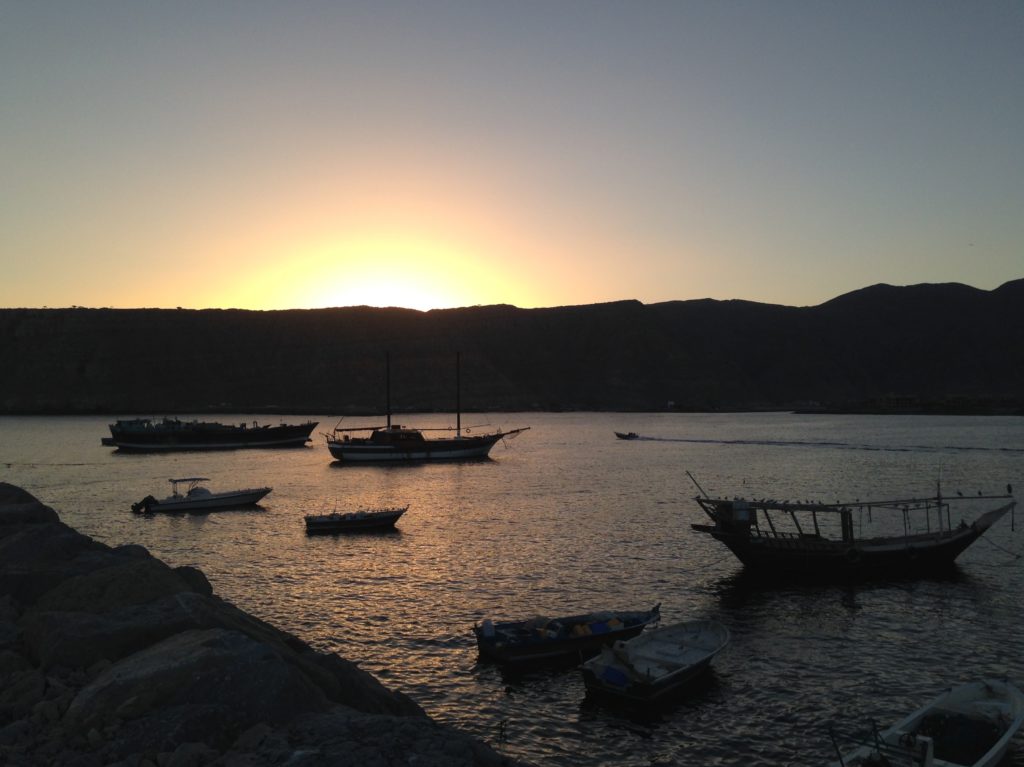
[i] “A Collection of Treaties and Engagements relating to the Persian Gulf Shaikhdoms and the Sultanate of Muscat and Oman in force up to the End of 1953” Accessed online at Qatar Digital Archives: http://www.qdl.qa/en/archive/81055/vdc_100023550810.0x00002b
[ii] U.S. Energy Information Administration,“World Oil Transit Chokepoints” (November 10, 2014).
[iii] http://www.theglobeandmail.com/life/the-most-important-nowhere-on-earth/article17984471/
[iv] “Musandam and Its Trade with Iran. Regional Linkages Across the Strait of Hormuz”, Michael Benz in S. Wippel (ed.), Regionalizing Oman: Political, Economic and Social Dynamics, United 205 Nations University Series on Regionalism 6, Springer Science+Business Media Dordrecht 2013
[v] http://nationalinterest.org/blog/irans-self-defeating-vision-oman-12140
[vi] http://www.presstv.ir/Detail/2015/12/20/442563/Iran-Oman-joint-drill
[vii] http://gcaptain.com/maersk-tigris-at-anchor-in-bandar-abbas-crew-safe/#.VncB1horLq0

